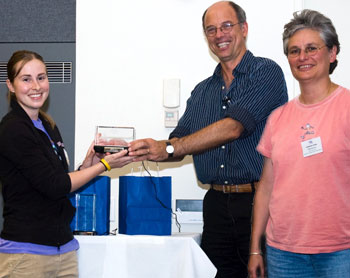(l-r) Natalie Funk, Markus Meister, and Catherine Dulac
(l-r) Itay Budin and Markus Meister
Two MCB graduate students were recognized for their academic achievement at MCB’s 2009 retreat at Harvard in September.
This year’s Peralta Prize was awarded to Natalie Funk of the Andrew Murray lab for her graduate thesis proposal, “Investigation of a Tension-Sensing Mechanism in the Spindle Checkpoint: The Ipl1-Cohesin Sliding Ring Model.” Itay Budin of the Jack Szostak lab at Massachusetts General Hospital (MGH) received the 2nd annual Meselson Prize for his experiment, “Self-Assembly of Model Protocells in a Thermal Diffusion Column.” Each prize includes $1,500 for travel or training and $1,000 for unrestricted enjoyment.
The Peralta Prize is awarded annually to one MCB graduate student entering the third year of study and recognizes the most outstanding dissertation proposal submitted by 2nd year graduate students. It is given in memory of MCB Prof. Ernest Peralta, who passed away tragically in 1999.
The Meselson Prize was begun in 2008 commemorating the 50th anniversary of the groundbreaking 1958 experiment by MCB Professor Matthew Meselson and Franklin Stahl – at the time a Caltech grad student and post-doc, respectively. This experiment proved that DNA replication occurs when each strand copies itself to produce two identical daughter strands. The experiment validated the then hotly debated double-helix model of DNA proposed by James Watson and Francis Crick five years earlier. Brilliantly conceived and expertly executed, the Meselson-Stahl work has been called “the most beautiful experiment in biology.” The Meselson Prize for “the most beautiful experiment of the year” is awarded to an MCB graduate student or team.
Natalie Funk’s Outstanding Dissertation Proposal
Natalie Funk’s work focuses on a major unsolved problem in the biology of cell division, how chromosomes sense tension and use it as a signal of correct attachment to the mitotic spindle. When chromosomes are properly attached to the spindle, tension is generated across the sister chromatids and their kinetochores, the large protein complexes that facilitate microtubule-chromatid connections. When tension is sensed on all chromosomes, cells are able to undergo division. This mechanism is part of the checkpoint system that helps ensure the proper segregation of genetic material during cell division. Mistakes in this segregation can cause aneuploidy, a hallmark of both cancer and birth defects.
The outside examiner on the selection committee praised Funk’s command of controversial and conflicting publications regarding the checkpoint and theories regarding the kinetochore. Past models proposed that tension within or between the kinetochores is sensed by the kinase Ip11, which is believed to reside within the kinetochore. Funk put forth a new model, proposing that the Ipl1 kinase is instead associated with cohesin rings that encircle chromatids and slide away in response to tension between kinetochores. It is this action that signals proper spindle attachment, ultimately allowing the chromatids to separate and cells to divide. For her dissertation project, Funk proposed a series of “well-reasoned experiments” for testing this hypothesis. When challenge by the committee, she defended her theory convincingly and with poise, confidence, and clear thinking. Her mentors, Andrew Murray and Richard Losick, wrote that “her performance at the bench matches her performance on the exam.”
Since her undergraduate studies in Biological Chemistry and French at Grinnell College, Funk has shown an interest in teaching, including as tutor in MCB 155 and teaching fellow in MCB 52 – where her performance was “so stellar that she was actively recruited” to continue the following term in an expanded capacity. Even as a second year graduate student, “Natalie shows a combination of intellectual grasp and pedagogical skill that many scientists are still struggling to reach.”
Itay Budin’s Beautiful Experiment to Test a Grand Theory
Itay Budin, a third year graduate student in the Engineering and Physical Biology training program, is interested in answering a long-standing question regarding the origin and early evolution of life. Scientists have proposed that life could have begun when fatty acids floating in the primordial soup formed primitive membranes that trapped polynucleotides inside them. However, the concentration of these molecules in the soup was likely too low for membrane self-assembly. In 2007, a theoretical paper in PNAS (Baaske et al.) predicted that deep sea vents could have featured microchannels with significant thermal gradients that could have dramatically concentrated dilute molecules.
When his advisor John Szostak at MGH expressed frustration at the lack of simple experiments to test such a grand theory, Budin and his fellow graduate student Raphael Bruckner decided to test it themselves. To Szostak’s great surprise, the experiments validated the prediction: gradients in temperature did result in gradients in the concentration of fatty acids in a solution. After publishing that experiment, Budin then used this effect to drive the self-assembly of membranes and even the co-assembly of cell-like vesicles containing DNA.
“I loved the experiment because it is so simple (just sandwich a capillary tube between a hot plate and cold plate), so surprising (the temperature gradient concentrates small molecules at the bottom of the capillary) and so elegant (thermal energy concentrates molecules, which then self-assemble into interesting higher-order structures),” Szostak wrote in nominating Budin’s “really beautiful experiment” for the Meselson Prize. In describing his experiment, Budin wrote, “Although we have little direct evidence of early biology, the use of synthetic approaches … will lead to plausible pathways for how life first began.” His experiment demonstrates “a simple and surprising physical phenomenon” that could be part of that pathway.




